South America
 The piaçava revival: Afro-indigenous crafts save a local tree species - Egnaldo Rocha da Silva finds that crafts play an important role in reviving the piaçave tree for descendants of Brazilian communities of escaped slaves.
The piaçava revival: Afro-indigenous crafts save a local tree species - Egnaldo Rocha da Silva finds that crafts play an important role in reviving the piaçave tree for descendants of Brazilian communities of escaped slaves.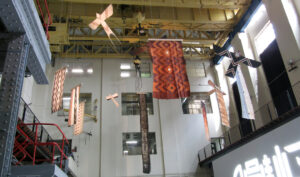 Ten Thousand Suns spotlights the technologies of First Nations peoples through craft - Pamela See reflects on the craft works in the 24th Sydney Biennale.
Ten Thousand Suns spotlights the technologies of First Nations peoples through craft - Pamela See reflects on the craft works in the 24th Sydney Biennale. Tiago Ishiyama ✿ It’s all or nothing in the favela - Paul Sepaniak pays tribute to his friend, an inspiring Brazilian street artist of Japanese ancestry
Tiago Ishiyama ✿ It’s all or nothing in the favela - Paul Sepaniak pays tribute to his friend, an inspiring Brazilian street artist of Japanese ancestry Capybara comes home - Yolanda Pocetti reintroduces the world's largest rodent to the busy commuters of Tigre.
Capybara comes home - Yolanda Pocetti reintroduces the world's largest rodent to the busy commuters of Tigre. A wall of dreams from southern Bahia - Maria Fernanda Paes de Barros constructs a free-standing wall for a Pataxó village that reflects a hands-on cultural dialogue.
A wall of dreams from southern Bahia - Maria Fernanda Paes de Barros constructs a free-standing wall for a Pataxó village that reflects a hands-on cultural dialogue.  Fragrant memories from Minas Gerais - Lena Emediato designs candles that use smell, touch and sight to tap into the emotions.
Fragrant memories from Minas Gerais - Lena Emediato designs candles that use smell, touch and sight to tap into the emotions. Smelling is believing - In a post-COVID moment, the powerful aroma of the exhibition Biomater prompts Liliana Ojeda to remember the importance of being there.
Smelling is believing - In a post-COVID moment, the powerful aroma of the exhibition Biomater prompts Liliana Ojeda to remember the importance of being there. Manchay P’uytu del Mapocho: A proposal to decolonise listening - Francisca Gili explores the musical legend of a bone flute played inside a ceramic vessel. How was it made and what did it mean?
Manchay P’uytu del Mapocho: A proposal to decolonise listening - Francisca Gili explores the musical legend of a bone flute played inside a ceramic vessel. How was it made and what did it mean? A gift of song from the valley - Maria Fernanda Paes de Barro explains how to "purchase" a song from the women of Jequitinhonha Valley.
A gift of song from the valley - Maria Fernanda Paes de Barro explains how to "purchase" a song from the women of Jequitinhonha Valley. Estudio Trindade and Rondinelly Santos ✿ Brazilian for life - Maria Fernanda Paes de Barro writes about two Brazilian tableware makers who bring a particular creative energy to the rituals of everyday life.
Estudio Trindade and Rondinelly Santos ✿ Brazilian for life - Maria Fernanda Paes de Barro writes about two Brazilian tableware makers who bring a particular creative energy to the rituals of everyday life.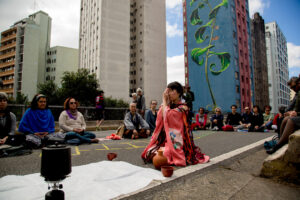 Erika Kobayashi ✿ A tea ceremony for Brazil - Liliana Morais interviews Brazilian performer Erika Kobayashi about how she updates the Japanese tea ceremony to suit the pulse of life in Brazil.
Erika Kobayashi ✿ A tea ceremony for Brazil - Liliana Morais interviews Brazilian performer Erika Kobayashi about how she updates the Japanese tea ceremony to suit the pulse of life in Brazil. Brasilidade: Samba on a plate - Nina Coimbra’s tableware captures the feeling of “Brasildade”, the poly-sensory experience of life in Brazil.
Brasilidade: Samba on a plate - Nina Coimbra’s tableware captures the feeling of “Brasildade”, the poly-sensory experience of life in Brazil.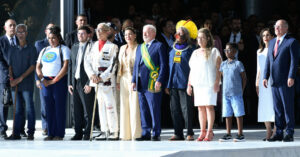 Welcome support for world knowledge-keepers: The Ministry of Indigenous Peoples in Brazil - Maria Fernanda Paes de Barros shares welcome news of support for Indigenous peoples in the new Lula government of Brazil.
Welcome support for world knowledge-keepers: The Ministry of Indigenous Peoples in Brazil - Maria Fernanda Paes de Barros shares welcome news of support for Indigenous peoples in the new Lula government of Brazil. Animita Ayúdame Papito: “So help me, father.” - Vania Ruiz discovers a Chilean folk tradition that she uses to bring her father back into her life.
Animita Ayúdame Papito: “So help me, father.” - Vania Ruiz discovers a Chilean folk tradition that she uses to bring her father back into her life. Art protects us and our shared world: Two messages from Indigenous Brazil - Arassari Pataxó and Kulikyrda “Stive” Mehinaku bring the cultures of Pataxó and Mehinaku peoples to the metropolis.
Art protects us and our shared world: Two messages from Indigenous Brazil - Arassari Pataxó and Kulikyrda “Stive” Mehinaku bring the cultures of Pataxó and Mehinaku peoples to the metropolis. Paula Isola ✿ The words to wear it - Our April laurel goes to Argentinean jeweller, Paula Isola, for three brooches that weave a text of desire.
Paula Isola ✿ The words to wear it - Our April laurel goes to Argentinean jeweller, Paula Isola, for three brooches that weave a text of desire. Manzanito ✿ A national hero of rural craft - Our Craft Currencies issue is dedicated to Luis Manzano Cabello, a rural artisan whose magic forms uplifted Chilean craft and inspired pride in vernacular traditions.
Manzanito ✿ A national hero of rural craft - Our Craft Currencies issue is dedicated to Luis Manzano Cabello, a rural artisan whose magic forms uplifted Chilean craft and inspired pride in vernacular traditions. Eyes for Chile 👁️👁️ Ojos Para Chile - Liliana Ojeda and Aranda Feres Ojeda gather eyes and words to make visible the recent political oppression on the streets of Santiago.
Eyes for Chile 👁️👁️ Ojos Para Chile - Liliana Ojeda and Aranda Feres Ojeda gather eyes and words to make visible the recent political oppression on the streets of Santiago.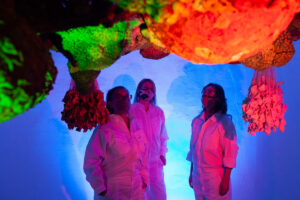 Biomater: Life hanging by a thread - Catalina Mena reflects on the exhibition in Chile by Clarisa Menteguiaga, Liliana Ojeda, and Paulina Villalobos, which witnesses the beauty of decay in the gallery.
Biomater: Life hanging by a thread - Catalina Mena reflects on the exhibition in Chile by Clarisa Menteguiaga, Liliana Ojeda, and Paulina Villalobos, which witnesses the beauty of decay in the gallery. The spirit of Japanese mingei in Brazil - Our Reinventing the Wheel series considers the evolution of Japanese craft traditions in Brazil, as documented by Liliana Morais and Silvia Sasaoka.
The spirit of Japanese mingei in Brazil - Our Reinventing the Wheel series considers the evolution of Japanese craft traditions in Brazil, as documented by Liliana Morais and Silvia Sasaoka. From Japan to Brazil: The ceramics of Shoko Suzuki - Liliana Morais follows a Japanese ceramicist who built a kiln in order to make a life between Japan and Brazil.
From Japan to Brazil: The ceramics of Shoko Suzuki - Liliana Morais follows a Japanese ceramicist who built a kiln in order to make a life between Japan and Brazil. “I treat her like a queen”: Chilean embroidery with attitude - Daniela Lara Espinoza turns the craft of her maternal forebears into a political voice for today’s generation.
“I treat her like a queen”: Chilean embroidery with attitude - Daniela Lara Espinoza turns the craft of her maternal forebears into a political voice for today’s generation. Moitará: An exchange between São Paulo and the village of Kaupüna - Maria Fernanda Paes de Barros takes us to a Xingu village where she partakes of the moitará exchange to commission work for her furniture.
Moitará: An exchange between São Paulo and the village of Kaupüna - Maria Fernanda Paes de Barros takes us to a Xingu village where she partakes of the moitará exchange to commission work for her furniture.  Cantarino: Reanimating the whistling bottles of the Andes - Francisca Gili Hanisch revives an ancient object that invests water with music for the afterlife.
Cantarino: Reanimating the whistling bottles of the Andes - Francisca Gili Hanisch revives an ancient object that invests water with music for the afterlife.  putiya makara wingani (can’t stop feeling) - Greg Lehman and Camila Marambio dialogue across the Pacific Ocean about the ancient now in Tasmania and the settler future in Chile.
putiya makara wingani (can’t stop feeling) - Greg Lehman and Camila Marambio dialogue across the Pacific Ocean about the ancient now in Tasmania and the settler future in Chile.  Ayvu Rapyta ✿ A selection - Andrea Ferrari presents a part of her translation of Ayvu Rapyta, the sacred myth of the Mbya people of South America, compiled in the twentieth century by Leon Cadogan
Ayvu Rapyta ✿ A selection - Andrea Ferrari presents a part of her translation of Ayvu Rapyta, the sacred myth of the Mbya people of South America, compiled in the twentieth century by Leon Cadogan Taller Grulla ✿ The forest at hand - Our January laurel goes to a Chilean workshop that makes objects for daily life inspired by earth and forest.
Taller Grulla ✿ The forest at hand - Our January laurel goes to a Chilean workshop that makes objects for daily life inspired by earth and forest.  Reborn in the Wenumapu: The meaning of the eclipse in Mapuche culture - Macarena de Lapreyra transcribes an interview with Mapuche artisan Luis Catricura about the meaning of the solar eclipse in their cosmovision.
Reborn in the Wenumapu: The meaning of the eclipse in Mapuche culture - Macarena de Lapreyra transcribes an interview with Mapuche artisan Luis Catricura about the meaning of the solar eclipse in their cosmovision. Paola Moreno ✿ Rhythms of Chile - Paola Moreno's modernist weaving is inspired by the many strands of Chilean culture, including precious textile relics of its ancient Inca past and passions of Violeta Parra.
Paola Moreno ✿ Rhythms of Chile - Paola Moreno's modernist weaving is inspired by the many strands of Chilean culture, including precious textile relics of its ancient Inca past and passions of Violeta Parra. Paula do Prado ✿ My abuela’s hands - Paula do Prado shares the story of her family’s epic story from Africa via Uruguay to Australia, as reflected in her intricately threaded creations.
Paula do Prado ✿ My abuela’s hands - Paula do Prado shares the story of her family’s epic story from Africa via Uruguay to Australia, as reflected in her intricately threaded creations. Pillan: The spirit of the volcano - The Mapuche silversmith Celeste Painepan Nicul tells how she acquired her cosmovision.
Pillan: The spirit of the volcano - The Mapuche silversmith Celeste Painepan Nicul tells how she acquired her cosmovision. Translating the Ayvu Rapyta: For the love of a rainforest and its word-souls - Andrea Ferrari reflects on the experience of translating the Mbya origin story, compiled into Spanish by León Cadogan, but read for the first time in English.
Translating the Ayvu Rapyta: For the love of a rainforest and its word-souls - Andrea Ferrari reflects on the experience of translating the Mbya origin story, compiled into Spanish by León Cadogan, but read for the first time in English. Forging alliances with nature: Atlas Botánico de Chile en Joyería - Lucía Nieves Cortés shares a series of jewellery objects that activate a relationship between humans and plants in her adopted country.
Forging alliances with nature: Atlas Botánico de Chile en Joyería - Lucía Nieves Cortés shares a series of jewellery objects that activate a relationship between humans and plants in her adopted country. Pilwas: Knotting Lafkenche narratives in Puerto Saavedra - Magdalena Cattan-Lavin travels south to learn about the Mapuche string bag and how its popularity has been revived.
Pilwas: Knotting Lafkenche narratives in Puerto Saavedra - Magdalena Cattan-Lavin travels south to learn about the Mapuche string bag and how its popularity has been revived.  The Kaikai of Rapanui - Marcela Garrido Díaz shares a string figure from Rapa Nui, accompanied by its traditional chant.
The Kaikai of Rapanui - Marcela Garrido Díaz shares a string figure from Rapa Nui, accompanied by its traditional chant. New Kashpij: Sailing spirits in deep time from the end of the world - Rita Soto Ventura makes horsehair jewellery inspired by the folklore of the Yagan peoples from Tierra del Fuego
New Kashpij: Sailing spirits in deep time from the end of the world - Rita Soto Ventura makes horsehair jewellery inspired by the folklore of the Yagan peoples from Tierra del Fuego Especies Acuñadas: Divesting colonial currency - Milena Moena Moreno seeks to deconstruct the symbolic capital associated with the colonisation of Mapuche in Chile.
Especies Acuñadas: Divesting colonial currency - Milena Moena Moreno seeks to deconstruct the symbolic capital associated with the colonisation of Mapuche in Chile. Mapuche hybrid identify furnished from the periphery - Rodrigo Castro Hueche follows his family’s furniture work to craft objects that reflect a hybrid Mapuche identity.
Mapuche hybrid identify furnished from the periphery - Rodrigo Castro Hueche follows his family’s furniture work to craft objects that reflect a hybrid Mapuche identity. Heirs of Llalliñ: Mapuche women weavers find the end of the rainbow - Artesanías de Chile invited Mapuche weavers to the Museum of Natural History, where they studied ancient textiles that they would re-create back home.
Heirs of Llalliñ: Mapuche women weavers find the end of the rainbow - Artesanías de Chile invited Mapuche weavers to the Museum of Natural History, where they studied ancient textiles that they would re-create back home. Te Hosek’en Harw: The Edge of the World - In consultation with the Selkn’am community, Sol Contardo created ceramic works inspired by their mysterious culture, located in Tierra del Fuego.
Te Hosek’en Harw: The Edge of the World - In consultation with the Selkn’am community, Sol Contardo created ceramic works inspired by their mysterious culture, located in Tierra del Fuego. Cupinzeiros: Back in touch with childhood - Lidia Lisbôa creates her cupinzeiros (termite mounds) as a way to stay in touch with her childhood home.
Cupinzeiros: Back in touch with childhood - Lidia Lisbôa creates her cupinzeiros (termite mounds) as a way to stay in touch with her childhood home. The Afro-Peruvian cajón: Reclaiming a humble percussion crate as one’s own - Aromica Bhattacharya tracks a percussion crate from its invention by African slaves to its eventual acknowledgment as intrinsic to Peruvian cultural heritage.
The Afro-Peruvian cajón: Reclaiming a humble percussion crate as one’s own - Aromica Bhattacharya tracks a percussion crate from its invention by African slaves to its eventual acknowledgment as intrinsic to Peruvian cultural heritage. Wenu Pelón: On curating ancient craft objects of present indigenous cultures - Lucía Nieves Cortés interviews Mapuche video artist Francisco Huichaqueo about his challenge to evoke the spirit of objects captured in a museum
Wenu Pelón: On curating ancient craft objects of present indigenous cultures - Lucía Nieves Cortés interviews Mapuche video artist Francisco Huichaqueo about his challenge to evoke the spirit of objects captured in a museum The shoemaker and the goat breeder - Carolina Hornauer tells a story about Planea foundation and how it helps pair complementary crafts for local benefit.
The shoemaker and the goat breeder - Carolina Hornauer tells a story about Planea foundation and how it helps pair complementary crafts for local benefit. Charazani Project: Inca weaving revived - Constanza Urrutia Wegmann draws on a traditional Inca textile pattern to create a mesmerising weaving.
Charazani Project: Inca weaving revived - Constanza Urrutia Wegmann draws on a traditional Inca textile pattern to create a mesmerising weaving. Kamaquen: Ceramics powered by Andean energy - For Keka Ruiz-Tagle, ceramics channels the spirits of her Inca ancestors.
Kamaquen: Ceramics powered by Andean energy - For Keka Ruiz-Tagle, ceramics channels the spirits of her Inca ancestors. Cielo rojo (red sky) - Caco Honorato and Mariela Vicencio create fragile objects inspired by the poetry of broken wings.
Cielo rojo (red sky) - Caco Honorato and Mariela Vicencio create fragile objects inspired by the poetry of broken wings. Made with lava in Chile - The Santiago design workshop Great Things to People recover deep geology to make objects for life today.
Made with lava in Chile - The Santiago design workshop Great Things to People recover deep geology to make objects for life today. ¡Bravo Joya Brava! - Liliana Ojeda writes about the creation of an art guild in Chile that over ten years has given meaning to the art form of
¡Bravo Joya Brava! - Liliana Ojeda writes about the creation of an art guild in Chile that over ten years has given meaning to the art form of 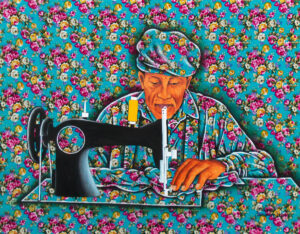 The garden of Gildásio - Gildásio Jardim relates a remarkable life story, reflecting the experience of a tiny rural community in paintings that magically blend with real life.
The garden of Gildásio - Gildásio Jardim relates a remarkable life story, reflecting the experience of a tiny rural community in paintings that magically blend with real life.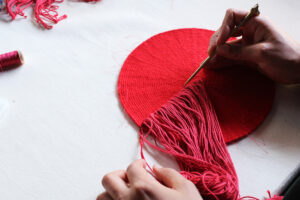 Circular heritage: Textile legacy in the Andes - Daniela Contreras Flores is inspired by the Chimú ceremonial costume to create an iris-like woven form.
Circular heritage: Textile legacy in the Andes - Daniela Contreras Flores is inspired by the Chimú ceremonial costume to create an iris-like woven form. Paola Moreno ✿ Healing plus - Our May laurel goes to Chilean textile artist Paola Moreno for a beautifully woven yet simple message of positivity for our time.
Paola Moreno ✿ Healing plus - Our May laurel goes to Chilean textile artist Paola Moreno for a beautifully woven yet simple message of positivity for our time.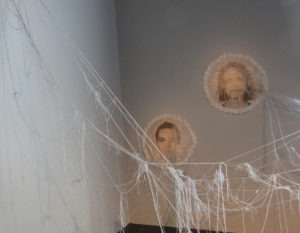 A post-digital threat out of the labyrinth: Christus Nobrega review - Pamela See finds that the embroidery exhibition Labirinto by Christus Nobrega offers a post-digital means of housing the past.
A post-digital threat out of the labyrinth: Christus Nobrega review - Pamela See finds that the embroidery exhibition Labirinto by Christus Nobrega offers a post-digital means of housing the past. Christus Nóbrega ✿ Remaking the past with lace - Christus Nóbrega journeyed his ancestral homeland in Brazil and found local lace makers to recover his family history.
Christus Nóbrega ✿ Remaking the past with lace - Christus Nóbrega journeyed his ancestral homeland in Brazil and found local lace makers to recover his family history. Democracy by hand in Chile - Textile artists can re-make flags to give a human dimension to a nation. Paola Moreno and Carolina Varela have made a powerful work in immediate response to the current crisis in Chilean democracy.
Democracy by hand in Chile - Textile artists can re-make flags to give a human dimension to a nation. Paola Moreno and Carolina Varela have made a powerful work in immediate response to the current crisis in Chilean democracy. Kukuli Velarde ✿ A mi vida - Our August laurel goes to Peruvian-born ceramic artist Kukuli Velarde for her poignant effigy, A mi vida. This object reflects the culture of her birth, her maternal love and concern for child victims of anti-immigrant campaigns.
Kukuli Velarde ✿ A mi vida - Our August laurel goes to Peruvian-born ceramic artist Kukuli Velarde for her poignant effigy, A mi vida. This object reflects the culture of her birth, her maternal love and concern for child victims of anti-immigrant campaigns. Lecture: Garland at University of Santiago – August 14 - The current Garland journey will conclude in South America, December 2020. In preparation, a lecture in collaboration with Fundación Wechoyen will be presented describing the journey thus far.
Lecture: Garland at University of Santiago – August 14 - The current Garland journey will conclude in South America, December 2020. In preparation, a lecture in collaboration with Fundación Wechoyen will be presented describing the journey thus far. A tactile collaboration from Brazil ✿ Ernesto Neto and Ibã Sales - In solidarity with Brazil's Indigenous peoples, facing a repressive new government, we share a story of an artistic collaboration between a Brazilian artist Ernesto Neto and Huni Kuin artist Ibã Sales.
A tactile collaboration from Brazil ✿ Ernesto Neto and Ibã Sales - In solidarity with Brazil's Indigenous peoples, facing a repressive new government, we share a story of an artistic collaboration between a Brazilian artist Ernesto Neto and Huni Kuin artist Ibã Sales.
 From Brazil to Japan: In search of the unknown craftsperson - Silvia Sasaoka recounts her journey in the footsteps of Soetsu Yanagi to find the spirit of Mingei (folk craft) in Japan today
From Brazil to Japan: In search of the unknown craftsperson - Silvia Sasaoka recounts her journey in the footsteps of Soetsu Yanagi to find the spirit of Mingei (folk craft) in Japan today  Liliana Ojeda ✿ November laurel - The November laurel goes to Chilean jewellery artist, Liliana Oleada. Her bold work uses her facility with materials to imagine internal forms within our body, making beauty from our hidden life forms.
Liliana Ojeda ✿ November laurel - The November laurel goes to Chilean jewellery artist, Liliana Oleada. Her bold work uses her facility with materials to imagine internal forms within our body, making beauty from our hidden life forms.  237 days: parallel / return - Black Matter is an Australia-Chile residency-based project that translates Gondwanian connections.
237 days: parallel / return - Black Matter is an Australia-Chile residency-based project that translates Gondwanian connections. Proyecto “Las Fábricas” – Last words and weaves in Santiago - Constanza Urrutia Wegmann describes an epic work to remember the death of Salvador Allende through the history of a textile factory in Santiago, Chile
Proyecto “Las Fábricas” – Last words and weaves in Santiago - Constanza Urrutia Wegmann describes an epic work to remember the death of Salvador Allende through the history of a textile factory in Santiago, Chile Mola, molas, mola-ing with the Kuna Yala in Panama - Bridget Nicholson she discovers how a textile like mola can be so central to a culture.
Mola, molas, mola-ing with the Kuna Yala in Panama - Bridget Nicholson she discovers how a textile like mola can be so central to a culture. Erika Diettes: Relics in amber - Alasdair Foster witnesses the work of Erika Diettes who cast objects of the disappeared in Colombia in a community memorial.
Erika Diettes: Relics in amber - Alasdair Foster witnesses the work of Erika Diettes who cast objects of the disappeared in Colombia in a community memorial. A semiotic thread: Maya Traditions Foundation’s Textiles Tour in Guatemala - Ann Fuata shares images of her journey to Guatemala to learn weaving with the Maya Traditions Foundation.
A semiotic thread: Maya Traditions Foundation’s Textiles Tour in Guatemala - Ann Fuata shares images of her journey to Guatemala to learn weaving with the Maya Traditions Foundation.  What object will we carry through the streets in 2168? - Could you imagine taking a precious museum object out of the cabinet and carrying it through the streets in an annual procession, celebrating our shared cultures?
What object will we carry through the streets in 2168? - Could you imagine taking a precious museum object out of the cabinet and carrying it through the streets in an annual procession, celebrating our shared cultures? Beyond the ethnographic turn: rethinking art and anthropology in Florianópolis, Brazil - Many of the articles in Garland so far have engaged with anthropology, particularly in the latest Moana issue. But rather than a purely scientific study of culture, the stories involve creative responses to a personal understanding of cultural values and customs.
Beyond the ethnographic turn: rethinking art and anthropology in Florianópolis, Brazil - Many of the articles in Garland so far have engaged with anthropology, particularly in the latest Moana issue. But rather than a purely scientific study of culture, the stories involve creative responses to a personal understanding of cultural values and customs. 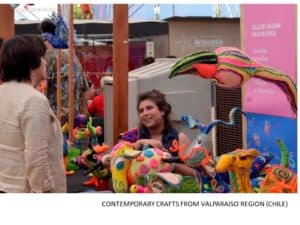 Muestra Artesanía, Santiago, December 2017 - Fresh from the 44th International Show of Traditional Crafts in Santiago, Chile, the President of World Crafts Council – Latin America, Alberto de Betolaza, shares with us some images of this important continental event. ✿ Like the article? Make it a conversation by leaving a comment below. If you believe in supporting a platform for culture-makers, consider becoming a subscriber.
Muestra Artesanía, Santiago, December 2017 - Fresh from the 44th International Show of Traditional Crafts in Santiago, Chile, the President of World Crafts Council – Latin America, Alberto de Betolaza, shares with us some images of this important continental event. ✿ Like the article? Make it a conversation by leaving a comment below. If you believe in supporting a platform for culture-makers, consider becoming a subscriber.  Xocolatlummm: Wearable chocolate from Colombia - Our friend Ana Berrio shares another remarkable project of Colombian street jewellery. For Joya Barcelona recently, she made a cart decorated in typical style and sold body ornaments made from chocolate for €10 each. Xocolatlummm included artists Titi Berrio, Alejandra Ferrer and Liliana Molina. Check the Instagram account: https://www.instagram.com/p/BaFcytQlGQ8/?taken-by=xocolatlummm ✿ Like the article? Make it a conversation by leaving a comment below. If you believe in supporting a platform for culture-makers, consider becoming a subscriber.
Xocolatlummm: Wearable chocolate from Colombia - Our friend Ana Berrio shares another remarkable project of Colombian street jewellery. For Joya Barcelona recently, she made a cart decorated in typical style and sold body ornaments made from chocolate for €10 each. Xocolatlummm included artists Titi Berrio, Alejandra Ferrer and Liliana Molina. Check the Instagram account: https://www.instagram.com/p/BaFcytQlGQ8/?taken-by=xocolatlummm ✿ Like the article? Make it a conversation by leaving a comment below. If you believe in supporting a platform for culture-makers, consider becoming a subscriber.  The beadworks of the Embera Chami tribe of Colombia - Ana Maria Parada writes about her enterprise Mami Watta Collections that promotes beadwork by Embera from her homeland in Colombia.
The beadworks of the Embera Chami tribe of Colombia - Ana Maria Parada writes about her enterprise Mami Watta Collections that promotes beadwork by Embera from her homeland in Colombia. The embroidered house - A project at A Casa museu do objeto Brasileiro, São Paulo City, commissioned local crafts from across Brazil to create a house of embroidery
The embroidered house - A project at A Casa museu do objeto Brasileiro, São Paulo City, commissioned local crafts from across Brazil to create a house of embroidery The road to Kilombu crosses many borders - Where is Kilombu? A Paraguayan-Brazilian artist living in Thailand collaborated with a Chinese ethnic silversmith to produce amulets for a special place in the world that embodies cultural freedom.
The road to Kilombu crosses many borders - Where is Kilombu? A Paraguayan-Brazilian artist living in Thailand collaborated with a Chinese ethnic silversmith to produce amulets for a special place in the world that embodies cultural freedom.  Nature craft - The traditional story of craft as an art of civilisation involves controlling nature. Fibre is spun, wood is carved, metal is cast, glass is blown and clay is thrown. Making seems to involve an improvement in the otherwise formless quality of materials found in the environment. Natural substances are mastered in order to manipulate them into forms of useful beauty.
Nature craft - The traditional story of craft as an art of civilisation involves controlling nature. Fibre is spun, wood is carved, metal is cast, glass is blown and clay is thrown. Making seems to involve an improvement in the otherwise formless quality of materials found in the environment. Natural substances are mastered in order to manipulate them into forms of useful beauty.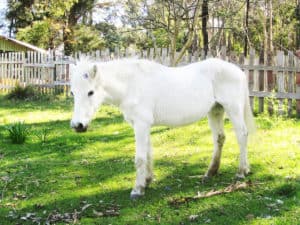 Chilean horsehair jewellery across the Pacific - Crin (horsehair) jewellery is idiomatic to Chilean culture. Trinidad Estay has taken this technique to the other side of the Pacific where it develops a close relationship to its equine origins.
Chilean horsehair jewellery across the Pacific - Crin (horsehair) jewellery is idiomatic to Chilean culture. Trinidad Estay has taken this technique to the other side of the Pacific where it develops a close relationship to its equine origins. Second Home by Camila Marambio - This is a reflection for the exhibition Second Home. As I roam the street of Brunswick I feel more like a hound than a human. Driven by need, want and pretense I hunt for a second home. My animal nature leads me to quiet streets, away from the noisy arteries, where I am all eyes, all ears, all nose, all heart, all skin. Relentlessly desirous, I scan the shapes, colors, sizes, configurations, and front gardens of house after house. Exercising quick judgment, yet postponing the actual jotting down of numbers and street names, what remains after each long drift is a hunger for the kill. I long to encounter a shell so beautiful, so uniquely formed, that it suits just […]
Second Home by Camila Marambio - This is a reflection for the exhibition Second Home. As I roam the street of Brunswick I feel more like a hound than a human. Driven by need, want and pretense I hunt for a second home. My animal nature leads me to quiet streets, away from the noisy arteries, where I am all eyes, all ears, all nose, all heart, all skin. Relentlessly desirous, I scan the shapes, colors, sizes, configurations, and front gardens of house after house. Exercising quick judgment, yet postponing the actual jotting down of numbers and street names, what remains after each long drift is a hunger for the kill. I long to encounter a shell so beautiful, so uniquely formed, that it suits just […] Second Home - Shelter is a key element of life on earth. Humans construct homes, birds weave nests, insects make cocoons, animals develop skin, sea creatures and nuts grow shells for protection.
Second Home - Shelter is a key element of life on earth. Humans construct homes, birds weave nests, insects make cocoons, animals develop skin, sea creatures and nuts grow shells for protection.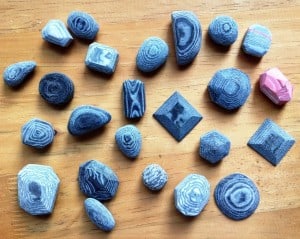 Geodenim ornament from the streets of Medellín - Alejandra Ruiz uses denim in jewellery as a way of reflecting life in Medellín, Colombia.
Geodenim ornament from the streets of Medellín - Alejandra Ruiz uses denim in jewellery as a way of reflecting life in Medellín, Colombia.